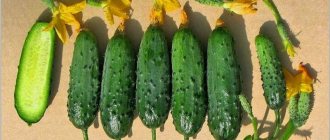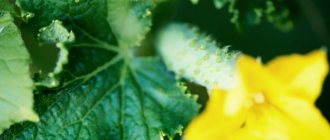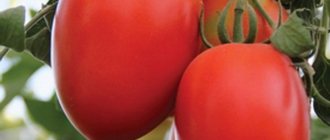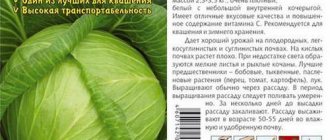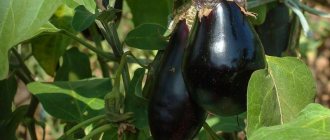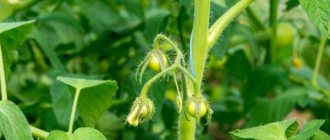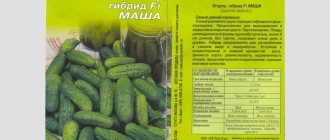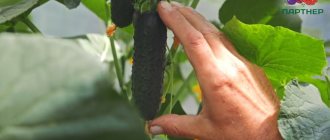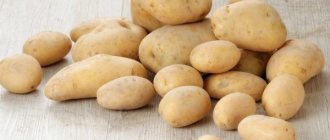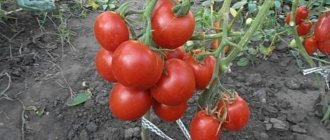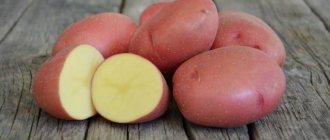Description of the variety
The Zyatek F1 variety is recommended for cultivation in greenhouses and hotbeds, using film shelters on personal summer cottages. When grown in open ground, good results can be obtained in regions such as the Krasnodar Territory, Rostov Region, and Stavropol Territory.
variety name contains the designation F1, which indicates that the cucumber is a hybrid. Exclusively the first generation of such species has a combination of improved characteristics of the varieties from which they originated.
Reference! When growing hybrids, it is not advisable to collect seeds from them due to the instability of genetic traits that are not preserved in subsequent generations.
Characteristics of the hybrid Zyatek F1 :
- The variety is early ripening, fruiting occurs in the period from 42 to 48 days after seedlings appear;
- It has female-type flowers (belongs to the parthenocarpic species) and does not require pollination by insects to produce fruits;
- It is classified as indeterminate (since its central stem is not limited in growth), has moderate branching, medium-sized leaves,
- It has a powerful root system and a strong stem;
- Rarely affected by powdery mildew, root rot, peronosporosis, easily tolerates diseases, and is capable of rapid recovery from them;
- It has a long fruiting period; regardless of the weather, it often lasts throughout September.
Advice! It is important to buy seeds from reliable producers, although they have a relatively high price, but at the same time they ensure the achievement of high germination rates and guarantee the presence of all the declared advantages of the variety.
Characteristics of Zyatek F1 cucumber :
- The average length is from 10 to 15 cm, diameter is about 3.5 cm;
- They have an average weight of 90 to 100g;
- They are distinguished by their skin containing delicate spines and covered with numerous small tubercles, which lacks bitterness;
- They are dark green in color, with light longitudinal stripes;
- They have dense pulp without bitterness, with a good sweetish taste;
- The leaf axils usually contain 2-8 ovaries;
- They can be grown both to the size of gherkins or pickles, and to a maximum size for direct consumption after they are removed from the plant;
- The yield indicator is about 13 kg/m. sq.;
- From one plant you can harvest from 5 to 7 kg of cucumbers over the entire fruiting period;
- They are not prone to overgrowing if the harvest is untimely, but they can acquire a barrel-shaped shape.
Important! It is better to pick cucumbers in a timely manner, since they have a good presentation, and the plants can direct all their efforts to the formation and growth of the next fruits.
Harvesting and storage
Harvesting of the Zyatek f1 variety begins, according to the description, in the last days of June. Fruiting of bushes can last more than 2 months - until the second half of September. Cucumbers ripen quickly and smoothly, so it is recommended to harvest the crop every morning, before watering the plantings. Zyatek is not prone to overgrowing, but the greens that linger on the branches acquire a sloppy barrel-shaped shape, their peel becomes hard.
Cucumber keeps well - about a week. It is best to store the variety in the refrigerator, or in a cold, dry cellar, at a temperature of 9-10. Zelentsy can easily withstand transportation even over long distances without being damaged or losing its presentation.
Photo
Below are photos of Zyatek cucumbers :
Agricultural technology of the Zyatek F1 variety
- We sow the seeds. If you plan to plant cucumbers in seedlings, then the seeds are sown in prepared peat pots in April. The root system of the variety is very delicate, so they are planted directly in pots in a permanent place of growth.
- We plant in open ground. As soon as the spring night frosts have passed, the temperature stabilizes, young seedlings are planted in the beds. During this period, you can sow seeds directly into open ground. The soil for cucumbers should be sandy loam and enriched with useful microelements.
- We water the cucumbers regularly. This crop is moisture-loving, so the plant requires normal watering, preferably in the evening. Cucumbers may respond to excess moisture by rotting the roots, as a result of which the bush may die. For irrigation, it is better to use settled warm water.
- We tie the long lashes of the plant to the support. To grow cucumbers, trellises are used, constructed from poles to which ropes are attached. As it develops, the stem will climb along them, clinging with its tendrils.
- We apply fertilizing in a timely manner. To increase the yield of a variety, it is necessary to regularly apply fertilizer to the bushes, preferably in liquid form. At the initial stage, young seedlings need mineral types of fertilizers, and later organic matter can be added. For this purpose, diluted bird droppings and mullein are used. Over the entire season, fertilizing is applied 4-5 times, but no more. An excess of microelements can lead to an increase in leaf mass, which will be at the expense of the formation of ovaries.
Popular: Description of the best varieties of strawberries for planting in the ground
Currently reading:
- Description of 12 types of late cabbage varieties for planting
- Description of the best tomato varieties for planting in 2021
- All the benefits of mulching the soil for high yields
- Confidentiality
Share the news on social networks
About the author: Victoria Semyonovna Nakhodkina
Leading researcher at the laboratory of vegetable and berry crops, Yakut Scientific Research Institute of Agriculture, Siberian Branch of the Russian Academy of Agricultural Sciences, Republic of Sakha (Yakutia).
Advantages and disadvantages
Hybrid Zyatek F1 has the following advantages:
- Excellent taste and appearance of the fruit;
- Possibility to choose a place for growing (in open ground or greenhouse);
- The versatility of fruit use;
- No need for pollination, due to the female type of flowering;
- The ability to grow small-sized fruits (pickles, gherkins);
- High overall yield;
- Resistance to adverse weather;
- Good survival rate of seedlings and high seed germination;
- Good preservation of fruits when transported over long distances;
- Unpretentiousness in care;
- High resistance to diseases (cladosporiosis, cucumber mosaic, etc.).
The disadvantage is the high cost of seed material.
Diseases and parasites
Son-in-law f1, according to the description, has a well-developed immune system. However, flaws in care can provoke infection with rot, and insufficiently clean weeding can attract parasites to the cucumber. Therefore, in order to prevent the crops of the variety from being destroyed by insect pests, in the fall the area is carefully dug up, removing all detected larvae and eggs of parasites.
Gray rot
The disease affects cucumbers during cold watering and high air humidity. Rot appears in the form of yellowish-brown weeping marks on the leaves of the variety. To cure the plantings, the beds are treated with a fungicide (Fitosporin, Roval, Thanos). Damaged shoots of the Zyatek plant need to be trimmed and the sections treated with charcoal powder or slaked lime.
Chafer
The larvae of this insect often eat up the tender roots of the variety, causing the bushes to dry out and wither. The best remedy for the parasite is deep digging of the cucumber area in autumn and spring, followed by collecting the larvae. You can also protect Zyatek f1 by planting nitrogen-producing plants around the area: white clover, lupins, or elderberries. Mulching the area under Zyatek with cabbage leaves also helps.
Medvedka
Another pest dangerous to the root system of the variety. To prevent the mole cricket from destroying all the seedlings, they try to find the nest of the parasite - it most often lies at a depth of 20-25 cm. A solution of soap or washing powder is poured into the discovered insect holes. The mole cricket is lured with traps filled with beer or kvass, dug at the borders of the cucumber plot. To prevent the proliferation of the pest, marigolds or chrysanthemums are planted around Zyatek f1 plants.
Features of cultivation
Growing Zyatek F1 cucumbers is not particularly difficult; you just need to follow basic agrotechnical measures in a timely manner.
Advice! If you purchase pelleted (specially treated) seeds, they should not be subjected to any additional preparation before sowing: soaking, hardening, pickling.
Hybrid Zyatek F1 can be grown using seedlings or sowing seeds directly into open ground. Air temperature has a great influence on how soon the first shoots appear:
- at +13°C, seed germination will not occur;
- if the air temperature is from +15 to +20°C, the seeds will sprout within 10 days;
- at a constant temperature above +25°C, seeds can germinate in 5 days.
Advice! The optimal temperature for sowing seeds is +20°C, which allows them to germinate quickly enough and at the same time ensures hardening.
The seeds of the Zyatek F1 are sown in a greenhouse or open ground from the end of spring; the depth of the holes for this should be about 2 cm. April is a suitable month to start preparing seedlings. It is transferred to a permanent place when 3-4 full-fledged leaves appear, approximately by the beginning of summer.
It is correct to use a 50x50 cm pattern for planting; it allows the cucumbers to get enough space for full growth and development, which ensures a good harvest.
Aftercare will include:
- Regular watering , which is carried out until the end of the fruiting period. It should not be excessively abundant, this can cause rotting of the roots;
- Weeding and loosening , which are recommended but optional procedures, if carried out carefully, they will help increase the amount of harvest, their maximum frequency should not exceed 1 time in 7 days;
- Feeding , which is especially necessary during the growing season. It is recommended to apply solutions of potassium-phosphorus fertilizers once every 7 days during evening watering; experienced gardeners advise feeding cucumbers with diluted manure. It is important to avoid over-application of fertilizers as this can cause plant death;
- Garter , which during active growth improves the illumination of the bushes, helps to properly direct the growth of young shoots;
- The harvest, which begins around the beginning of July and continues until the end of the fruiting period.
Care
Zyatek cucumbers are also demanding on soil moisture:
- It needs to be irrigated regularly.
- However, the plant does not need excessive moisture. Excess moisture can cause the roots to rot, causing the plant to die.
- It is recommended to grow Zyatek cucumbers on a trellis. It can be constructed using different methods. It is possible to install poles near each bush.
- The stems of young plants must first be directed towards them themselves. Next, the plant itself will cling to the support with its tendrils (modified leaves).
- It is possible to put ropes between the poles to form a trellis.
Growing cucumbers on a trellis:
- saves space;
- does not allow branches to intertwine;
- creates the best illumination for many fruits;
- improves conditions for watering and harvesting.
Do you prefer to grow cucumbers on a trellis?
Not really
The quantity and quality of stems must be adjusted. If the shoot has reached a length of half a meter, but no flowers or ovaries have appeared on it, it is pinched. It is important to remember that the Zyatek cucumber is a cross, and they do not produce empty flowers; a cucumber should form in place of any flower.
In order to get a large harvest of high-quality cucumbers, it is necessary to regularly feed the plants. Especially at a time when they are growing rapidly:
- Phosphorus and potassium are added. This can be either mineral fertilizers or organic matter.
- The cucumber needs carbon dioxide during the development of flowers. Its formation is facilitated by the introduction of organic matter.
- Many sources even advise laying mullein between the rows. However, he should not touch the stems of the plant. This is not easy to achieve. Since the lashes regularly grow. For this reason, it is preferable to irrigate with mullein infusion. Before this, 1 kg of manure is infused in a bucket of water for 10 days. Next, dilute it at the rate of 1 liter per 10 liters of water and water the plants no more than once a week.
